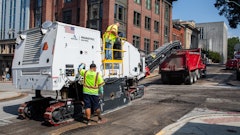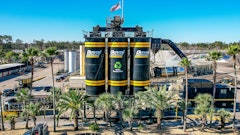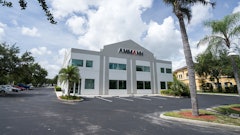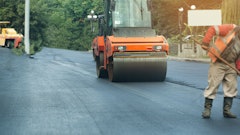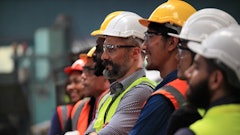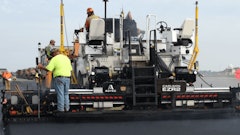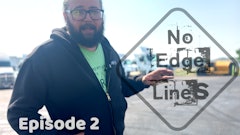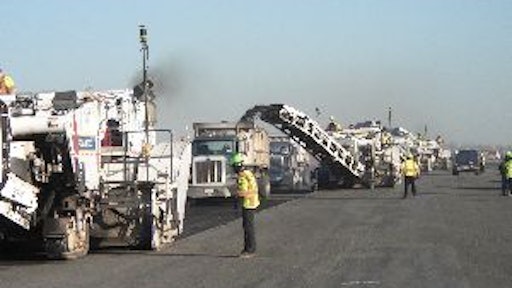
Advanced machine control technology has made its way into the paving and milling markets. "The most common type of 3D machine control on the market today is GPS," says Kevin Klein, vice president of engineering/research and development, GOMACO. Frequently used in earthmoving, Global Positioning System technology is now enabling contractors to move toward stringless and stakeless paving and pavement repair operations.
"3D technology on milling machines and asphalt pavers can help you build better roads for less," asserts Jeroen Snoeck, paving segment manager, Trimble. "With 3D technology, you can better control your yield, increase your smoothness, save valuable material and get rid of your stakes."
GPS by itself is not yet accurate enough for concrete paving. "GPS systems have a proclaimed accuracy of +/- 1cm. But in real life +/- 2cm or even worse is more likely on a day in and day out basis," Klein explains. "So we will use systems with robotic total stations (TPS or LPS) or a GPS system, which is augmented with some other technology such as lasers or total stations. With these types of systems, we can achieve accuracies up to +/- 3mm."
It's important to account for all the variables. "When applying the standard rules and limits of machine and system usage, you can fairly easily get a 3mm mean deviation on the milled surface," notes Matthias Fritz, Wirtgen. "The rules are basically good maintenance of the machine and tools (pics), reasonable milling speed (up to 15m/minute) and reasonable distances to the total station or laser."
Industry "breakthrough"
"The advantages [of 3D] are similar to what you get in the earthwork industry, where you have stakeless grading," says Jim Cleary, Cleary Machinery. "However, in the milling and paving industry, we don't put grade stakes in the ground; we paint marks on the ground. [With 3D controls], we eliminate those." The entire job is on an electronic data file.
Not using stakes or string can take some getting used to. "At first, contractors may be concerned in not having the stringline to measure from to ensure the paving is in the correct place," says Klein. "Once paving has started, and they have learned how to operate the survey equipment used to do the as-built checks, they realize how much easier it is."
Cleary, who is one of the most experienced Topcon dealers in the paving and milling market, has been doing machine control applications since the 1980s. Many of his clients work on airport runways. "There are more runways within 50 miles of Manhattan than possibly anywhere in the world," he says. "Before GPS, we had to set up stringline on runways. Stringline is only as accurate as the surveyor who sets each pin. It can get hit. It can blow in the wind. Guys will try to step over it and kick it by accident. They might even walk away and not tell anybody."
Stringline also limits use of multiple milling machines. "If you are running one milling machine, you could set up stringline," says Cleary. "But if you are running three milling machines on a runway, you can't do it. It's a logistical nightmare for trucks to maneuver in."
Yet, Cleary has demonstrated that multiple milling machines can work at the same time using GPS. On a project this spring at the John F. Kennedy airport in Queens, NY, Intercounty Paving Associates had five Roadtec RX-900 milling machines operating simultaneously to speed production. Three of the GPS-equipped machines were used to bulk mill the job, leaving the last 1 1/2 in. to be profile milled using two Topcon Millimeter GPS-equipped machines.
"That is the beauty of GPS. You have the entire job on a stick and on the machine," says Cleary. "This is an incredible breakthrough product for the milling and paving industry as far as I am concerned."
Paving benefits
Several tangible benefits arise from using 3D paver control. "Paving is all about the penalties," Cleary comments. For example, consider an airport runway where the spec is +/- .25 in. "You can't be more than a 1/2 in. out -- ever," he emphasizes.
The completed runway is usually divided up into lots. "You are graded on each lot. Typically, you must have at least 85% of your 'shots' within that .25 in. and the remaining 15% must be within a 1/2 in. to avoid the most costly penalty, which is mill and replace at contractor expense," Clearly explains.
He adds, "With inspection grades between 90% and 95%, typically there is no penalty. If you can do better than 95% -- which was almost unheard of before GPS arrived on the scene -- you have a bonus. This is what this product is going to bring to the industry. Paving margins aren't what they used to be; eliminating risk of penalties is a good thing."
The savings in materials through the increased accuracy provided by these systems can be substantial. "At $50 per ton for asphalt, you save $140,000 by laying 1/100th ft. less asphalt on a 10-mile-long, 72-ft.-wide road," notes Snoeck.
Such savings usually result when 3D technology is used to build the entire project from the ground up. "However, I expect that the savings come more from not having to set stringline in the first place, and the increased productivity on a jobsite by not having the stringline in place to have to work around," says Klein.
Replacing stringline with 3D technology has many benefits. "We are mainly talking about quality improvements, significant productivity improvements up to 50% and safety issues," says Fritz.
"The industry has been anxiously waiting for stingless paving," notes Klein. Let's assume you are paving 4,000 ft. a day and preparing the line ahead of the paver. "For five miles of straight paving, you have to pound in at least 2,150 stakes and set 10 miles of stringline. Then, you go back and pull it all up, move down the line and store and inventory all of that material. So, the stringless system replaces that stringline crew, material, time and the entire stringline coordination and effort."
Tight deadlines also favor 3D systems. "The time savings are not unimportant, especially on airport projects," says Snoeck. "They often deal with tough deadlines."
By eliminating stringline, you also increase jobsite flexibility. "With 3D paving, you can go anywhere. You have flexibility in the movement of the machine, because anywhere the machine is at, it knows what the design is," says Snoeck. "With a continuous design, you actually look at where you are and where the design is."
Milling benefits
"The big advantage for 3D milling is you could gain increased production, as you can leave surfaces that are on design in place," says Snoeck. "Another big advantage is you can improve your smoothness. It is actually much easier to create that smooth surface with the mill, and go out with the paver and lay a fixed thickness of asphalt. It is very easy on that surface to create a nice, smooth lift of asphalt."
Trying to smooth out a waved surface with a paver is difficult. "The problem is differential compaction," Snoeck explains. "You may lay a smooth surface with the paver, but when you start rolling it, the asphalt will actually compact more above the low spots." Milling it smooth first prevents this problem and saves material.
"3D milling can also help you mill more complex designs -- for example, transitions and elevated curves," says Snoeck. Imperfections in the existing surface do not affect the final product. "Using 3D technology does not copy existing topography," says Fritz. "It is using planned data that is optimized by engineers; hence, any sort of waves or other uneven areas will be corrected regardless what the actual surface looks like. The technology allows precise redesign of roads in the field, saves material on the upper layers and ensures constant thickness, which is fundamental for long-term quality."
The surface prepared by a 3D-equipped milling machine is very accurate. "It almost makes the use of 3D systems on paving machines questionable," says Fritz. "However, there are many projects that do not require simple resurfacing, but need to be redesigned in regards to grade and profile. For all of these projects, 3D technology [on the paver] makes perfect sense."
Accuracy is also becoming more of an issue with mill and fill-type work. "Ten years ago, you would mill out 4 in., and then put back 4 in. in 2-in. lifts," says Cleary. "There was a lift of base and a lift of top. You can recover a lot with two lifts of asphalt." It provides more room to correct imperfections.
But the specs have become a lot more difficult to meet as project owners strive to cut costs. "You are seeing more 'mill 2 in. and fill 2 in.'," says Cleary. "There is less milling and less filling." The spec required for the finished surface hasn't changed -- you now have to mill to grade accurately to ensure you can make spec in one shot instead of two. "You have to have a system to do it right."
Work within the limits
As with any technology, there are limitations. "The machine has to be used within its given limitations, as well as [those of] the 3D system," says Fritz. "They both have to work together, which means if one part of the combination is exceeding its limits, it will have a direct impact on the result.
"Typical limitations are machine speed, line of sight to the instrument or satellites, radio communication and the availability of design data," he says. "On the other hand, if the machine is worn out and not maintained very well, or the material it is supposed to pave or cut is not good, even the best calibrated 3D system will not be able to fix it."
Purchase price can also pose a significant hurdle, as well. "Likely, the biggest limitation relates to the initial cost of the 3D system. Multiple machines on site or in a paving train obviously increase that initial cost," says Klein. "Another limitation is that total stations and lasers require line of site from the instruments to the paver, and GPS systems require unobstructed views to the satellite constellations."
The systems also call for surveyor expertise. "3D systems require contractors to have engineers and surveyors on site at all times to handle the instruments, do machine setups and verify that equipment is producing the desired result from the design files being used," Klein indicates. "This is oftentimes a change for many construction operations that are used to working from stringlines."
Of course, the quality of the design data is critical. "3D control systems can place more emphasis on the engineers and surveyors when they do their jobs in the first place," says Klein. "From our experience, the 'control points' on a jobsite are absolutely key to getting a good final result. If the surveyors are careless when they set out control points, accuracy of the machine control can suffer.
"Also, it is imperative for the engineer who is taking the digital design file and developing the machine control file to be used on the equipment to be accurate in the steps that he is taking," he continues. "The machines are going to build exactly what the design file tells them to build. So if there are problems built into the design file, there will also be problems in the final results." Fritz adds, "With all the 3D systems today, the machine will do whatever the design model is telling it to do, regardless whether it makes sense or not. There is clearly a higher responsibility on the [side of the] design engineer creating the data that will be put into the machine to assure that the design data will meet requirements in the field."
----------------------------------
Advantages of 3D Paving
According to Kevin Klein, GOMACO, there are several advantages to using 3D paving technology:
- Survey cost reduction: Grade control stakes are no longer necessary, and stringline stake-outs are eliminated.
- Cost savings: Savings can be realized because it is no longer necessary to set stringline in the first place.
- Less jobsite obstructions: Absence of stringline means jobsite traffic can move about more freely. This can mean better productivity for the entire process. Also, stringlines are prone to damage or displacement once they are in place.
- Move in and out on projects more quickly: It's no longer necessary to set up stringlines before paving production can begin, or take stringlines down once paving is completed.
- Reduced completion time: 3D controls can mean decreased total time for project completion.
- Improved accuracy: Contractors can realize improved accuracy of a project when working from a digital plan from the beginning.
- Data logging ability: It is possible to log certain data or events that can be examined at a later date for quality control or other reasons.











